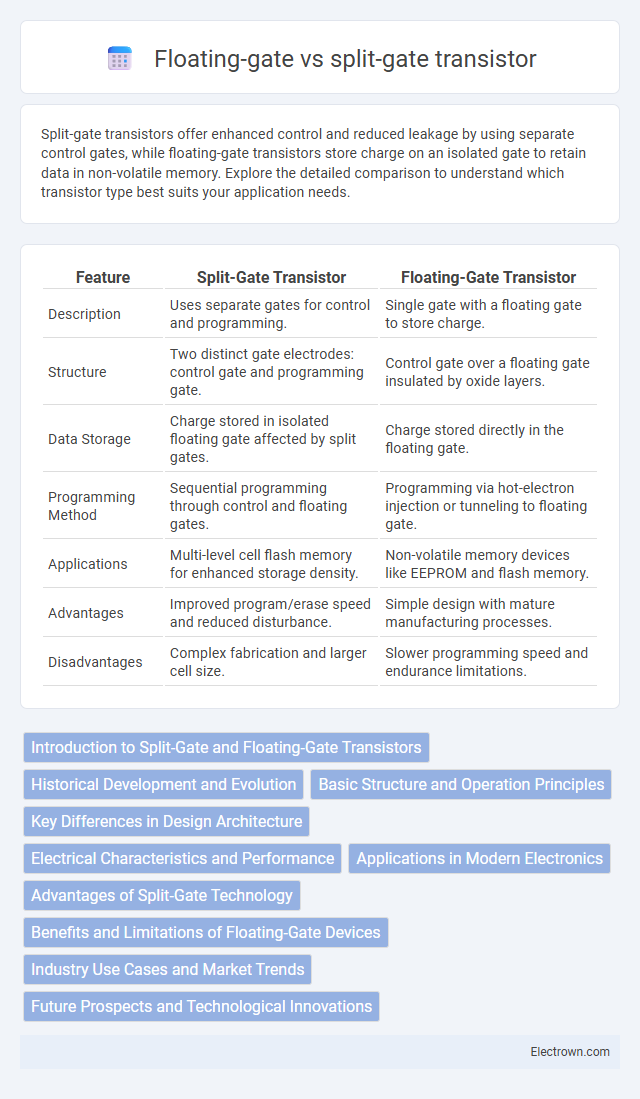Split-gate transistors offer enhanced control and reduced leakage by using separate control gates, while floating-gate transistors store charge on an isolated gate to retain data in non-volatile memory. Explore the detailed comparison to understand which transistor type best suits your application needs.
Table of Comparison
| Feature | Split-Gate Transistor | Floating-Gate Transistor |
|---|---|---|
| Description | Uses separate gates for control and programming. | Single gate with a floating gate to store charge. |
| Structure | Two distinct gate electrodes: control gate and programming gate. | Control gate over a floating gate insulated by oxide layers. |
| Data Storage | Charge stored in isolated floating gate affected by split gates. | Charge stored directly in the floating gate. |
| Programming Method | Sequential programming through control and floating gates. | Programming via hot-electron injection or tunneling to floating gate. |
| Applications | Multi-level cell flash memory for enhanced storage density. | Non-volatile memory devices like EEPROM and flash memory. |
| Advantages | Improved program/erase speed and reduced disturbance. | Simple design with mature manufacturing processes. |
| Disadvantages | Complex fabrication and larger cell size. | Slower programming speed and endurance limitations. |
Introduction to Split-Gate and Floating-Gate Transistors
Split-gate transistors feature two separate gate electrodes controlling the channel, enhancing charge control and reducing leakage, which improves memory cell performance. Floating-gate transistors store charge on an isolated gate electrode, enabling non-volatile memory applications like flash storage by retaining data without power. Understanding these transistor types helps optimize your memory design for speed, reliability, and data retention.
Historical Development and Evolution
Floating-gate transistors, invented in the late 1960s, revolutionized non-volatile memory by enabling data retention without power, forming the backbone of EEPROM and flash memory technologies. Split-gate transistors emerged in the 1980s as an advancement to improve device performance and scaling, featuring separate control and floating gates to enhance reliability and reduce interference. Your understanding of these technologies highlights the pivotal evolution from early memory designs to modern, high-density storage solutions.
Basic Structure and Operation Principles
Split-gate transistors feature two control gates that independently regulate the channel, enhancing programming accuracy and reducing interference in memory cells. Floating-gate transistors contain a single control gate and a floating gate insulated by oxide layers, which stores charge to represent data by altering the threshold voltage. Your choice between these transistor types impacts memory design efficiency, data retention, and scaling capabilities.
Key Differences in Design Architecture
Split-gate transistors feature two separate gates that independently control the flow of carriers, allowing precise manipulation of the channel and improved memory cell stability. Floating-gate transistors contain a single gate with an electrically isolated floating gate embedded in the oxide layer, which stores charge to retain data non-volatilely. The split-gate design reduces interference and program-disturb issues common in floating-gate architectures, enhancing reliability and endurance for flash memory applications.
Electrical Characteristics and Performance
Split-gate transistors exhibit faster programming speeds and lower voltage requirements compared to floating-gate transistors, due to their reduced capacitive coupling and improved charge control. Floating-gate transistors offer superior data retention and endurance, enabled by the fully isolated charge storage in the floating gate structure. Electrical performance differences also include higher threshold voltage variability in floating-gate devices, while split-gate designs provide enhanced erase efficiency and reduced disturb effects.
Applications in Modern Electronics
Split-gate transistors are primarily utilized in non-volatile memory applications such as flash memory due to their improved charge retention and faster write/erase speeds. Floating-gate transistors remain the cornerstone of EEPROM and traditional flash memory technologies, offering reliable data storage through trapped charge in the floating gate. Emerging applications in neuromorphic computing and analog memory leverage split-gate structures for enhanced control over threshold voltage and reduced power consumption.
Advantages of Split-Gate Technology
Split-gate transistors offer enhanced charge control and reduced leakage currents compared to floating-gate transistors, resulting in improved data retention and endurance for non-volatile memory applications. Their architecture allows for precise programming and erasing with lower power consumption, making them well-suited for high-density flash memory devices. The scalability and reliability of split-gate technology contribute to longer device lifespan and better performance in advanced semiconductor manufacturing processes.
Benefits and Limitations of Floating-Gate Devices
Floating-gate transistors offer non-volatile memory storage with high data retention and dense integration, making them ideal for flash memory applications. However, they face limitations such as slower write speeds, higher programming voltages, and susceptibility to charge leakage over time. Your choice between split-gate and floating-gate devices should consider these trade-offs based on endurance, reliability, and device complexity requirements.
Industry Use Cases and Market Trends
Split-gate transistors are increasingly favored in memory applications for their superior scalability and lower power consumption, making them ideal for next-generation NAND flash memory used in smartphones and data centers. Floating-gate transistors maintain dominance in traditional non-volatile memory markets like SSDs and USB drives, benefiting from established manufacturing processes and widespread adoption. Understanding your application's performance and endurance requirements will help determine whether split-gate or floating-gate technology aligns better with evolving industry demands and market trends.
Future Prospects and Technological Innovations
Split-gate transistors offer enhanced scalability and improved resistance to charge leakage compared to floating-gate transistors, making them ideal for next-generation non-volatile memory applications. Technological innovations in split-gate designs focus on reducing programming voltages and increasing endurance, which addresses limitations faced by traditional floating-gate technology. Future prospects emphasize integration with advanced semiconductor processes and emerging memory architectures such as 3D NAND and neuromorphic computing, driving higher performance and energy efficiency.
Split-gate vs floating-gate transistor Infographic

 electrown.com
electrown.com